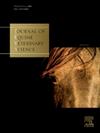Predictors of epistaxis incidence in Thoroughbred racehorses in the United States
IF 1.6
3区 农林科学
Q2 VETERINARY SCIENCES
引用次数: 0
Abstract
Epistaxis (EP), or bleeding from the nose, may negatively impact racehorse health and performance. To test the hypothesis that a combination of quantifiable factors could predict susceptibility to an EP event, a database of Thoroughbred racehorses experiencing EP unrelated to physical trauma for 2024 in the United States was collated. Data for all horses experiencing EP (n = 202) and all non-EP horses from the same races (n = 1286) were included for analysis. Twenty-five potential risk parameters were extracted from veterinary exams, race data, and environmental factors. The correlations (r) of these risk factors with EP incidence were used to choose predictors for the parsimonious models. Logistic regression modeling was performed using Python due to the binomial distribution of the outcome variable of interest (EP). Weighted logistic regression models with the top 5 (Model 1) and 10 (Model 2) correlated risk factors were compared for model performance (Table 1). Within model 1, EP diagnosis had a positive relationship (P < 0.0001) in the fitted model, whereas off odds had a negative correlation (P = 0.04). Model 1 achieved a high average accuracy score of 84%. For predicting non-EP, precision, recall, and F1-score of model 1 were all 90%. Predictive EP capability of model 1 was moderate, with precision, recall, and F1-score values all being 48%. The receiver operating characteristic area under the curve (ROC-AUC) score for this model was 69%, indicating significant utility of model 1 in predicting EP. Within model 2, which had the top 10 strongest correlations, previous EP was the most significant predictor (P < 0.0001), similar to model 1. Precision, recall, and F1-score for predicting non-EP were all 90% for model 2, as well. For predicting EP, these scores were 46%, 48%, and 47%, respectively. Model 2 had similar model performance statistics as model 1, with an accuracy score of 83% and a ROC-AUC score of 69%. Our analysis favored model 1 to predict EP, due to its parsimonious nature. Further evaluation with advanced models, such as XGBoost and Random Forests, is recommended to gain a more comprehensive understanding of the factors influencing epistaxis.
美国纯种马鼻出血发生率的预测因素
鼻出血(EP)或鼻出血可能会对赛马的健康和表现产生负面影响。为了验证可量化因素组合可以预测EP事件易感性的假设,对2024年美国经历EP与身体创伤无关的纯种马数据库进行了整理。所有经历EP的马(n = 202)和所有来自同一比赛的非EP马(n = 1286)的数据被纳入分析。从兽医检查、种族数据和环境因素中提取25个潜在风险参数。这些危险因素与EP发病率的相关性(r)用于选择简约模型的预测因子。由于感兴趣的结果变量(EP)的二项分布,使用Python进行逻辑回归建模。比较前5个(模型1)和10个(模型2)相关危险因素的加权logistic回归模型的模型性能(表1)。在模型1中,EP诊断呈正相关(P <;0.0001),而off odds呈负相关(P = 0.04)。模型1的平均准确率达到了84%。对于非ep预测,模型1的准确率、召回率和f1得分均为90%。模型1的预测EP能力中等,准确率、召回率和f1评分值均为48%。该模型的受试者工作特征曲线下面积(ROC-AUC)评分为69%,表明模型1在预测EP方面具有显著的实用性。在模型2中,相关性最强的前10位,先前的EP是最显著的预测因子(P <;0.0001),与模型1相似。模型2预测非ep的准确率、召回率和f1得分均为90%。对于预测EP,这些分数分别为46%,48%和47%。模型2的模型性能统计数据与模型1相似,准确率得分为83%,ROC-AUC得分为69%。由于模型1的简约性,我们的分析倾向于模型1来预测EP。建议使用XGBoost和Random Forests等先进模型进行进一步评估,以更全面地了解影响鼻出血的因素。
本文章由计算机程序翻译,如有差异,请以英文原文为准。
求助全文
约1分钟内获得全文
求助全文
来源期刊

Journal of Equine Veterinary Science
农林科学-兽医学
CiteScore
2.70
自引率
7.70%
发文量
249
审稿时长
77 days
期刊介绍:
Journal of Equine Veterinary Science (JEVS) is an international publication designed for the practicing equine veterinarian, equine researcher, and other equine health care specialist. Published monthly, each issue of JEVS includes original research, reviews, case reports, short communications, and clinical techniques from leaders in the equine veterinary field, covering such topics as laminitis, reproduction, infectious disease, parasitology, behavior, podology, internal medicine, surgery and nutrition.
 求助内容:
求助内容: 应助结果提醒方式:
应助结果提醒方式:


